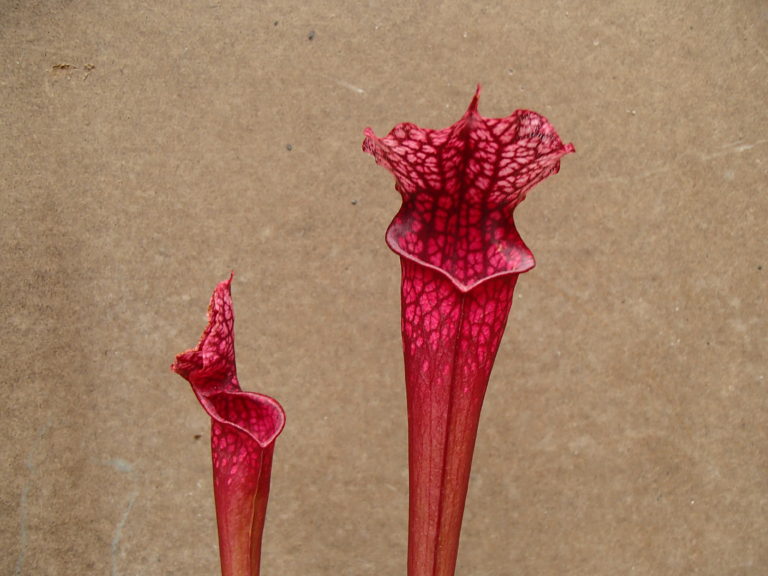‘Daina’s Delight’ is one of the largest and showiest of the carnivorous pitcherplants we sell at Cure Nursery, with beautiful pitchers up to 3 feet tall. The pitcher consists of a green to rusty red throat or tube, that begins the season deep red but later sports a striking white, ruffled hood (pinkish in the sun) with bold red venation. Although ‘Daina’s Delight’ is a hybrid (Sarracenia leucophylla x Sarracenia x willisii) developed in New Zealand, it’s genes are local as the genus Sarracenia is endemic to North America! The flowers of ‘Daina’s Delight’ are a deep red and dangle from a tall, upright stem, drooping down to form an upside down umbrella shape. Sarracenias evolved to thrive in nutrient poor habitats and meet their nitrogen and phosphorus needs from the insects trapped in the pitchers. ‘Daina’s Delight’ is easily grown in 50/50 peat moss and perlite or sand kept reliably moist with rainwater or deionized water (NO fertilizer), in full sun out of doors, or in a sunny bog garden where it can have access to winter temperatures. Some folks grow Sarracenias in pots indoors (set in a tray of water) and overwinter them in an unheated garage or outbuilding.
NURSERY HOURS
Wednesday: 10-4 Thursday: 10-6 Friday-Saturday: 10-4 Sunday: 12-4
Sarracenia x ‘Daina’s Delight’

Key Info
Scientific Name: Sarracenia x 'Daina's Delight'
Common Names: Daina's Delight
Family Names: Sarraceniaceae
Light Requirement: Full sun
Flower Color: Red
Additional Info
Habit: Sarracenias are clump-forming herbaceous perennials that grow as rosettes from a branching rhizome, forming colonies and containing fibrous roots 8-12 inches long along its length. The pitchers are modified leaves that (in addition to their function of photosynthesis) attract and entrap their insect prey by means of colorful presentation and nectar production (like flowers) and modifications to prevent escape. Wikipedia has a concise treatment of Sarracenia's entrapment mechanisms.
Height: 2'-3'
Spread: 1'-2'
Soil Conditions: Moist or wet, nutrient-poor, peaty, acidic soils.
Leaves: Semi-deciduous, upright pitcher-shaped leaves with "lid" on the top which prevents excess water pooling in the pitcher. Leaves are maroon at the base with dark red lacy veins at the white top. 'Dana's Delight' also has non-carnivorous, sword-shaped leaves which photosynthesize. The showiest pitchers are formed in the fall .
Flowers (or reproductive structures: In spring, the drooping flowers on 20" stems are green. Over time they will darken to a deep pink in full sun, resembling an upside down umbrella. Flowers are held above the pitchers, avoiding entrapment of pollinators.
Fruit: The seed pod forms at the top of the upside-down umbrella (flower) is a dry capsule that splits open along 5 seams at maturity (June/July) exposing from 20-300 small, papery, pear-shaped seeds. The seeds fall near the parent plant. Seeds of 'Dana's Delight' will not be true. Propagate by division.
Natural Distribution: Sarracenias live in any permanently moist site including swamps, lake edges, river banks, boggy pine forests, or other low-lying areas. They cannot live in permanently flooded areas, but survive well in areas that experience temporary seasonal floods and submersion. They cannot tolerate long-term drought.
USDA Hardiness Zone: 6 to 9
USDA Wetland Indicator Status in NC: OBL
Pollination: Bees, and other insects.
Wildlife Connections: Obtains nutrients (nitrate and phosphate) from insects. Insects and other tiny creatures are attracted by the nectar and coloration of the traps. The main prey of Sarracenias are ants, flies, wasps, bees, beetles, slugs and snails.
Propagation: A hybrid cross, 'Dana's Delight' is propagated by division.
